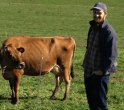By Kirsten Workman, Agronomy Outreach Professional
Farmers are planting cover crops at a rapidly increasing rate across Vermont – and for good reasons. The water quality and soil health benefits of this farming practice are undeniable. However, a farmer who manages that cover crop in a spring like this one will attest to the added complexity cover crops bring to the challenges of growing annual crops in Vermont.
Through our work with many innovative producers in the Champlain Valley, we identified the need to think about planting cover crops differently. We should not only ask questions about how late we can plant or how to get the most biomass possible, but can we take a more nuanced approach to decision making? In order to use cover crops as a management tool, a farmer should first decide on the goal for that cover
crop, and then implement a plan to accomplish that goal.
The main goal is usually to reduce erosion and nutrient loss. However, are you also trying to reduce weed pressure, decrease nitrogen applications for the subsequent crop? Will you be interseeding into a standing crop? Do you want to maximize spring biomass either to harvest it as forage or to use a rollercrimper device? Or, maybe you hope to minimize spring biomass to ease spring field management without sacrificing erosion control and nutrient retention.
The latter example is one goal we have heard from many producers who value the role cover crops play in reducing soil and nutrient loss in the sensitive fall and early spring seasons, but who don’t want so much biomass to deal with in the spring when it’s time to plant annual
crops, especially on heavier soils.
Borrowing an idea from one such farm, last fall we planted cover crop plots on nine farms, from Westford to Pawlet, on sandy loam to clay soils. Our goal was to determine the “magic” combination of seeding rates for planting winter rye and spring oats in the fall to maximize fall performance, while minimizing spring biomass. The dry fall and wet spring thwarted some of our efforts, but we were able to collect data at six locations. We don’t have the final answer yet, as one year doesn’t tell the whole story. However, we found that all combinations did comparably
well at providing at least 30% ground cover to protect from erosion in the fall. With the exception of the all-oat plots, all combinations increased soil cover and biomass from fall to spring.

This trial supported previous observations that winter rye – planted with a grain drill – provides similarly high biomass in the spring at different seeding rates, down to 45 pounds per acre. The two combinations that seemed to maximize fall performance and spring soil coverage while minimizing spring biomass were 30 pounds of rye with 45 pounds of oats, and 15 pounds of rye with 60 pounds of oats. The lowest rate of rye is probably not an advisable rate on steep ground, but it should provide enough soil coverage on flat ground.
Our aim is to help farmers identify the pros and cons of different methods of cover cropping, and evaluate which methods accomplish particular goals. We are moving beyond the basics in Vermont, and it is important to utilize this important conservation tool in a way that benefits not only the watershed, but also your farm.















